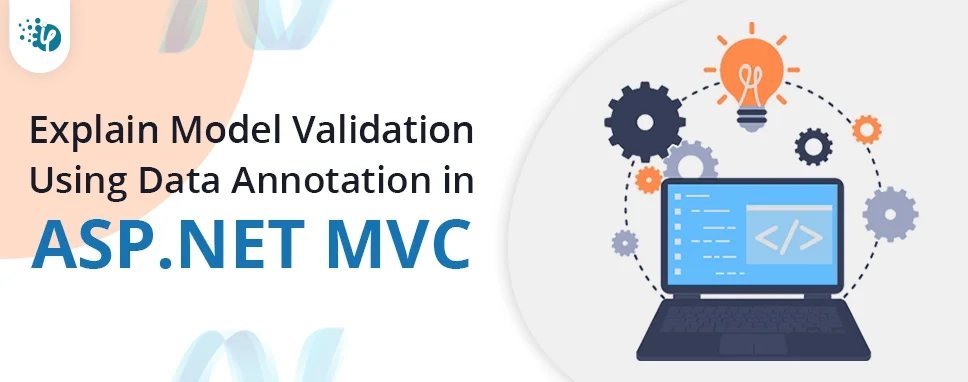Top 5 B2B SaaS Tools to Improve Team Communication
Do you want your workplace to have greater collaboration and teamwork? Staying in touch with coworkers is difficult in this era of remote work. In this changing world, the demand for...
Listening is fun too.
Straighten your back and cherish with coffee - PLAY !

Data Validation is an important aspect of developing web applications. It is used to check whether the user data entered is valid or not. To work on this, ASP.NET MVC offers Data Annotation attribute classes to modal class.
Data annotations are nothing but certain validations that are used with models to validate the user input from users. Data Annotation attribute classes are present in System.ComponentModel.DataAnnotations namespace is a powerful way to check for errors and, if necessary, display messages to the user.
This type of attribute specifies that the value cannot be skipped, user needs to enter the value for this field.
Syntax[Required(ErrorMessage=Message),MaxLength(int)]
Here MaxLength is option parameter
Example[Required(ErrorMessage = Name is Required ), MaxLength(20)]
[Required(ErrorMessage = "Email ID is Required")]
This type of attribute specifies that the value cannot be skipped, user needs to enter the value for this field.
Syntax[DataType(DataType.Text)]
Example[DataType(DataType.Currency)]
[DataType(DataType.Date)]
This type of attribute is used to specify the size of the column.
The StringLength attribute specifies the minimum and maximum length of the property.StringLength similar to a minimum and maximum length attributes but used only with string type properties.
Syntax[StringLength(MaximumLength, MinimumLength = value)]
[StringLength(MaximumLength, MinimumLength =value, ErrorMessage = "Message”)]
Example[StringLength(50, MinimumLength = 10)]
[StringLength(50, MinimumLength = 10, ErrorMessage = Do not enter more than 50 character and less than 10 character)]
Using this attribute, we can specify the minimum and maximum value for a numeric value.
Syntax[Range(minimum,maximum,ErrorMessage=Message)]
Example[Range(18,60,ErrorMessage=Age must between 18 to 60 )]
This type of attribute allows us to specify the property name displayed on the view.
Syntax[Display(Name=Name Display on View)]
Example[Display(Name=First Name)]
This attribute allows us to set the format specified as per the attribute.
Syntax[DisplayFormat(DataFormatString = specify format )]
Example[DisplayFormat(DataFormatString = {0:dd.MM.yyyy})]
Using this attribute, we can specify the maximum length of the property.
Syntax[MaxLength(value)]
Example[MaxLength(50,ErrorMessage="Description cannot be greater than 50")]
This type of attribute is used to specify the minimum length of string or an array property
Syntax[MinLength(value)]
Example[MinLength(20)]
[MinLength(20,ErrorMessage=Description cannot be less than 50)]
This type of attribute specifies fields to include and exclude properties for model binding.
Example[Bind(Exclude = UserId)]
[Bind(Include = UserId,Name,Email,Gender)]
We can set a pattern for the property for Ex we can set RegularExperssion for Email String
Example[RegularExpression(@^\w+([-+.']\w+)*@\w+([-.]\w+)*\.\w+([-.]\w+)*$, ErrorMessage = Enter Valid Email)]
Now, we need to create an MVC application for the data annotation demo. Create a new MVC application and inside the model, folder add a new class for model.
Right, click on model, click on add, and select class.
[Fig:- class for model]
Employee class
using System;
using System.ComponentModel.DataAnnotations;
namespace Dynamicappendpartial.Models
{
public class Employee
{
public int E_Id { get; set; }
[Required(ErrorMessage = "name Required")]
[Display(Name = "Full Name")]
[MaxLength(30), MinLength(10)]
public string Name { get; set; }
[Required(ErrorMessage = "gender Required")]
public string Gender { get; set; }
[Required(ErrorMessage = "Email Address Required")]
[Display(Name = "Email Address")]
[EmailAddress]
public string EmailAddress { get; set; }
[Required(ErrorMessage = "Postion Required")]
public string Position { get; set; }
[Required(ErrorMessage = "Hire Date Required")]
[Display(Name = "Hire date")]
[DisplayFormat(DataFormatString = "{0:dd.MM.yyyy}")]
public DateTime HireDate { get; set; }
[Required(ErrorMessage = "salary Required")]
[DataType(DataType.Currency)]
[Range(15000, 60000, ErrorMessage = "salary must between 15000 to 60000")]
public int Salary { get; set; }
[Required(ErrorMessage = "Website Required")]
[Display(Name = "Personal Website")]
[Url]
public string WebSite { get; set; }
}
}
Add controller inside the controller folder.
EmployeeController
using System;
using System.Collections.Generic;
using System.Data;
using System.Data.Entity;
using System.Linq;
using System.Net;
using System.Web;
using System.Web.Mvc;
using Dynamicappendpartial.Models;
namespace Dynamicappendpartial.Controllers
{
public class EmployeesController: Controller
{
private PartialDbContext db = new PartialDbContext();
public ActionResult Index()
{
return View(db.Employees.ToList());
}
public ActionResult Details(int? id)
{
if (id == null)
{
return new HttpStatusCodeResult(HttpStatusCode.BadRequest);
}
Employee employee = db.Employees.Find(id);
if (employee == null)
{
return HttpNotFound();
}
return View(employee);
}
public ActionResult Create()
{
return View();
}
[HttpPost]
[ValidateAntiForgeryToken]
public ActionResult Create([Bind(Include = "Id,Name,Gender,EmailAddress,Position,HireDate,Salary,WebSite")] Employee employee)
{
if (ModelState.IsValid)
{
db.Employees.Add(employee);
db.SaveChanges();
return RedirectToAction("Index");
}
return View(employee);
}
public ActionResult Delete(int? id)
{
if (id == null)
{
return new HttpStatusCodeResult(HttpStatusCode.BadRequest);
}
Employee employee = db.Employees.Find(id);
if (employee == null)
{
return HttpNotFound();
}
return View(employee);
}
[HttpPost, ActionName("Delete")]
[ValidateAntiForgeryToken]
public ActionResult DeleteConfirmed(int id)
{
Employee employee = db.Employees.Find(id);
db.Employees.Remove(employee);
db.SaveChanges();
return RedirectToAction("Index");
}
}
}
Right-click on Create method and add the view for create method.
@model Dynamicappendpartial.Models.Employee
@{
ViewBag.Title = "Create";
}Create
@using (Html.BeginForm())
{
@Html.AntiForgeryToken()
Employee
@Html.ValidationSummary(true, "", new { @class = "text-danger" })
@Html.LabelFor(model => model.Name, htmlAttributes: new { @class = "control-label col-md-2" })
@Html.EditorFor(model => model.Name, new { htmlAttributes = new { @class = "form-control" } })
@Html.ValidationMessageFor(model => model.Name, "", new { @class = "text-danger" })
@Html.LabelFor(model => model.Gender, htmlAttributes: new { @class = "control-label col-md-2" })
@Html.EditorFor(model => model.Gender, new { htmlAttributes = new { @class = "form-control" } })
@Html.ValidationMessageFor(model => model.Gender, "", new { @class = "text-danger" })
@Html.LabelFor(model => model.EmailAddress, htmlAttributes: new { @class = "control-label col-md-2" })
@Html.EditorFor(model => model.EmailAddress, new { htmlAttributes = new { @class = "form-control" } })
@Html.ValidationMessageFor(model => model.EmailAddress, "", new { @class = "text-danger" })
@Html.LabelFor(model => model.Position, htmlAttributes: new { @class = "control-label col-md-2" })
@Html.EditorFor(model => model.Position, new { htmlAttributes = new { @class = "form-control" } })
@Html.ValidationMessageFor(model => model.Position, "", new { @class = "text-danger" })
@Html.LabelFor(model => model.HireDate, htmlAttributes: new { @class = "control-label col-md-2" })
@Html.EditorFor(model => model.HireDate, new { htmlAttributes = new { @class = "form-control" } })
@Html.ValidationMessageFor(model => model.HireDate, "", new { @class = "text-danger" })
@Html.LabelFor(model => model.Salary, htmlAttributes: new { @class = "control-label col-md-2" })
@Html.EditorFor(model => model.Salary, new { htmlAttributes = new { @class = "form-control" } })
@Html.ValidationMessageFor(model => model.Salary, "", new { @class = "text-danger" })
@Html.LabelFor(model => model.WebSite, htmlAttributes: new { @class = "control-label col-md-2" })
@Html.EditorFor(model => model.WebSite, new { htmlAttributes = new { @class = "form-control" } })
@Html.ValidationMessageFor(model => model.WebSite, "", new { @class = "text-danger" })
}
@Html.ActionLink("Back to List", "Index")
Now, run the application and click on create and add details and check the model validation
[Fig:- model validation for empty field]
[Fig:- Model validation for Email]
[Fig:- Model validation for a salary]
In this blog, we have learned Data Annotations. It provides a list of attributes for model validation. Using different types of attributes, we create restrictions to a user if he enters data that is of invalid format or Invalid range.

Do you want your workplace to have greater collaboration and teamwork? Staying in touch with coworkers is difficult in this era of remote work. In this changing world, the demand for...

Life is inconceivable without technologies, isn’t it? Cellphones, laptops, apps, and automobiles are all examples of how technology became an integral part of our life. It acts as...

The use of environmental sensors is a common practice in the field of hazard management. These sensors continuously monitor the environment for flammable gases and toxic vapours. In...